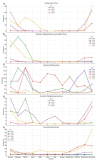Increased risk during winter: common respiratory viruses and clinical outcomes in hospitalized children
- PMID: 40253326
- PMCID: PMC12008977
- DOI: 10.1186/s12879-025-10950-2
Increased risk during winter: common respiratory viruses and clinical outcomes in hospitalized children
Abstract
Background: Acute respiratory infections (ARIs) are a leading cause of hospitalisation, severe morbidity, and mortality in children, representing a significant public health concern. This study aimed to evaluate the clinical features, laboratory findings, and outcomes of pediatric patients hospitalised due to ARIs caused by common respiratory viruses, including influenza virüs (IFV), human bocavirus (hBoV), human metapneumovirus(hMPV), human rhinovirus (hRV), and human respiratory syncytial virüs (hRSV).
Methods: We conducted a retrospective analysis of 1465 hospitalized pediatric patients at Ankara Bilkent City Hospital Children's Hospital between August 2019 and March 2024. Nasopharyngeal swabs were analyzed using multiplex real-time PCR to identify viral pathogens. Clinical data, including demographics, intensive care needs, respiratory support, and chronic health conditions, were reviewed.
Results: A total of 1465 hospitalized children were included in the study, with a median age of 3 years and 61.8% being male. Of these patients, 32.9% (n = 482) had chronic health conditions. IFV was detected in 30.1% of patients, hBoV in 28.3%, hRSV in 18.4%, hRV in 14.4%, and hMPV in 8.8%. Over half of the infections occurred during the winter months, with IFV being the most commonly observed virus. Fever was most frequently observed in IFV cases, while cough and hypoxia were more prevalent in hBoV and hRSV infections. Admission to the Pediatric Intensive Care Unit was necessary in 19.5% of cases, with 33.1% of these requiring invasive mechanical ventilation. Invasive mechanical ventilation was most frequently required in hBoV cases. The mortality rate was 8.7%, predominantly observed in patients with chronic health conditions; hBoV was associated with the highest mortality.
Conclusion: This study provides a comprehensive analysis of the clinical, laboratory, and radiological characteristics of children hospitalized due to viral lower respiratory tract infections, offering valuable insights into common respiratory pathogens. The findings underscore a higher incidence of these infections during the winter months. It is recommended that hBoV and IFV infections be closely monitored in children with underlying chronic conditions. Moreover, the study highlights the importance of meticulous management of hBoV and hRSV infections, given their association with an increased need for intensive care support.
Keywords: Human bocavirus; Human metapneumovirus; Human respiratory syncytial virus; Human rhinovirus; Influenza virus; Lower respiratory tract infections.
© 2025. The Author(s).
Conflict of interest statement
Declarations. Ethics approval and consent to participate: This study was conducted in accordance with the ethical standards of the institutional and national research committees, and with the 1975 Helsinki Declaration and its later amendments. Ethical approval was granted by the Ethics Committee of Ankara Bilkent City Hospital. As the study was retrospective in nature, the requirement for obtaining informed consent from participants was waived by the Ethics Committee of Ankara Bilkent City Hospital, in accordance with. General consent for the use of medical records in research was obtained as part of the routine admission process where applicable. Consent for publication: No interventions were performed on any patients for the purposes of this study; only existing medical records were utilized. Data was anonymized and confidentiality was maintained in compliance with ethical standards. The information used was in accordance with the general consent provided by patients at the time of their admission to the hospital. Competing interests: The authors declare no competing interests. Clinical trial registration: This study does not involve any clinical trials. Therefore, no clinical trial registration is required.
Figures
Similar articles
-
Etiology, seasonality, and clinical characterization of viral respiratory infections among hospitalized children in Beirut, Lebanon.J Med Virol. 2016 Nov;88(11):1874-81. doi: 10.1002/jmv.24544. Epub 2016 May 19. J Med Virol. 2016. PMID: 27061822 Free PMC article.
-
Infections and coinfections by respiratory human bocavirus during eight seasons in hospitalized children.J Med Virol. 2016 Dec;88(12):2052-2058. doi: 10.1002/jmv.24562. Epub 2016 May 6. J Med Virol. 2016. PMID: 27124519 Free PMC article.
-
Changes in the Etiology of Acute Respiratory Infections among Children in Novosibirsk, Russia, between 2019 and 2022: The Impact of the SARS-CoV-2 Virus.Viruses. 2023 Apr 9;15(4):934. doi: 10.3390/v15040934. Viruses. 2023. PMID: 37112913 Free PMC article.
-
Atypical causes of respiratory virus infections in Sub-Saharan Africa from 2013- 2023: a systematic review and meta-analysis.BMC Infect Dis. 2025 May 6;25(1):668. doi: 10.1186/s12879-025-11028-9. BMC Infect Dis. 2025. PMID: 40329172 Free PMC article.
-
Rethinking Paediatric Respiratory Infections: The Role of Mixed Pathogen Infections.Rev Med Virol. 2025 Mar;35(2):e70021. doi: 10.1002/rmv.70021. Rev Med Virol. 2025. PMID: 40000823 Review.
References
-
- Nicole LC, Regina P, Cecilia V, Constanza MV, Tania L, Marcela M, et al. Relevance of codetection of respiratory viruses in the severity of acute respiratory infection in hospitalized children. Andes Pediatrica: Revista Chil De Pediatria. 2021;92:349–58. - PubMed
-
- Kusel MMH, De Klerk NH, Holt PG, Kebadze T, Johnston SL, Sly PD. Role of respiratory viruses in acute upper and lower respiratory tract illness in the first year of life: a birth cohort study. Pediatr Infect Dis J. 2006;25:680–6. - PubMed
MeSH terms
LinkOut - more resources
Full Text Sources
Medical




